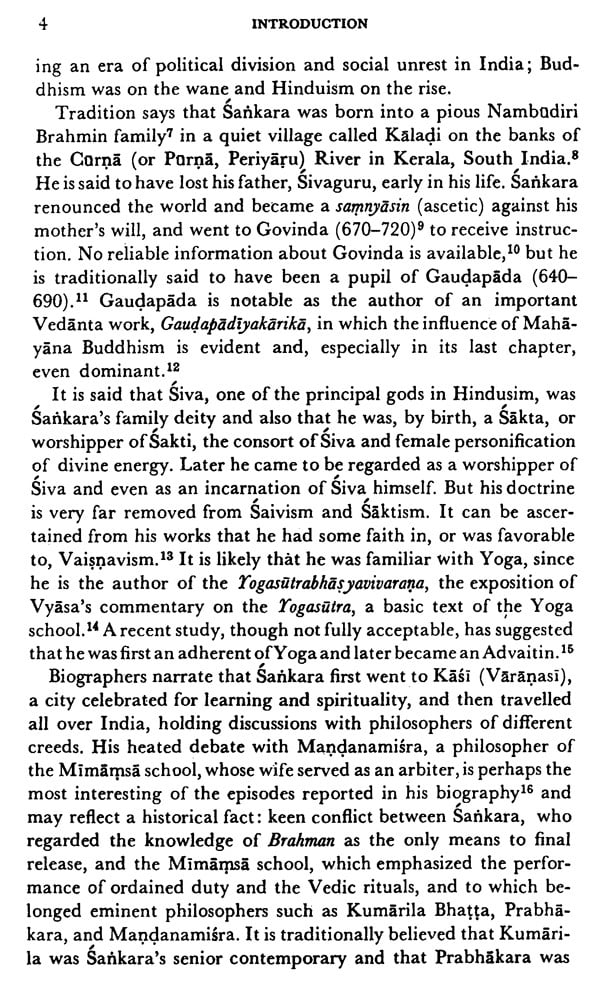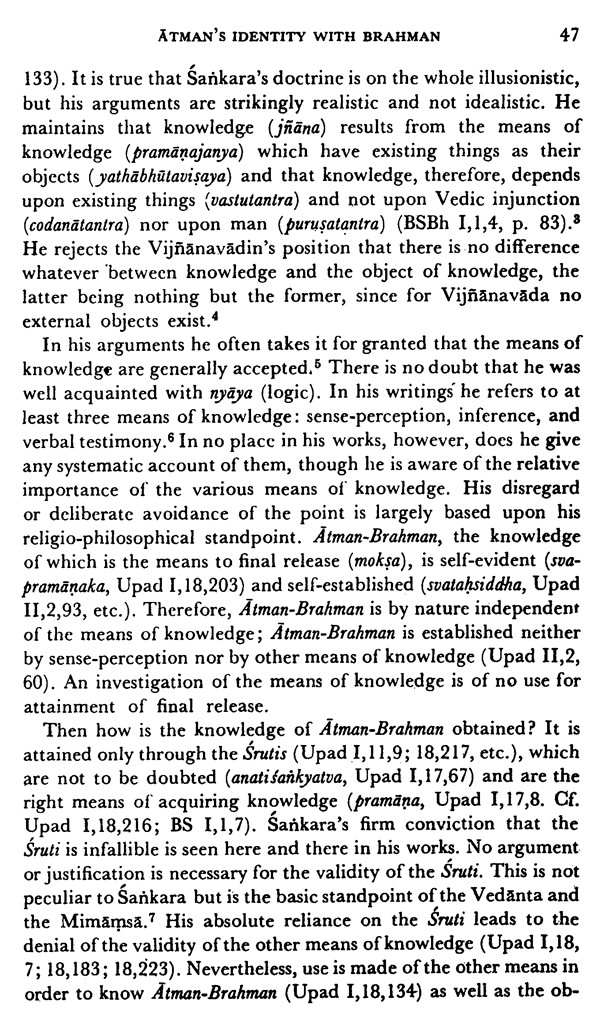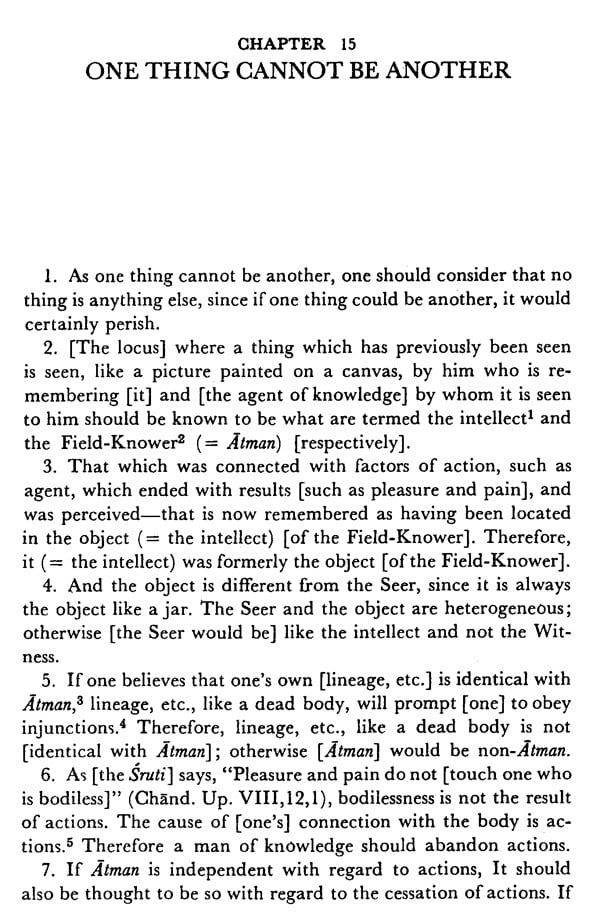
A Thousand Teachings: The Upadesasahasri Of Sankara
Book Specification
| Item Code: | IDI719 |
| Author: | Sengaku Mayeda, Foreword by John M. Koller |
| Publisher: | Motilal Banarsidass Publishers Pvt. Ltd. |
| Edition: | 2006 |
| ISBN: | 9788120827714 |
| Pages: | 287 |
| Cover: | Paperback |
| Other Details | 8.3" X 5.4 |
| Weight | 336 gm |
Book Description
Sankara (700-750) has usually been regarded as the greatest philosopher of India since P. Deussen praised his philosophy and compared it with those of Parmenides and Kant. It has also been pointed out that, like Meister Eckhart, he was not so much a philosopher as a theologian. Sankara was indeed a metaphysician or theologian, but, like Gotama Buddha and other great religious teachers, he was primarily concerned with the salvation of people suffering in transmigratory existence here in this present world and not with the establishment of a complete system of philosophy or theology.
This book contains an annotated English translation of Sankara's Upadesasahasri or "A Thousand [Verses of] Teachings," accompanied by an Introductory Essay. The translation is based upon my edition of the text which has been published in a roman-ized version of the Sanskrit (Sankara's Upadesasahasri, Critically Edited with Introduction and Indices. Tokyo: The Hokuseido Press, 1973).
As already stated in the Preface there, it is no my purpose to point out yet again the importance of the Upadesasahasri in the history of the Advaita Vedanta, which has been the main current of thought in India for many centuries. But it is perhaps necessary to describe briefly the character of the Upadesasahasri
The Upadesasahasri consists of two parts, one in verse and the other in prose. The verse or Metrical Part (Padyabandha) comprises nineteen chapters (prakarana). Manuscripts indicate that the two parts were regarded as independent works, as it were, and studied or commented upon separately. They also suggest the possibility that any single chapter could be selected, copied, and studied apart from the rest. This means that reading of the text may begin anywhere.
In the Metrical Part, perforce translated here into prose, three kinds of meter are used, but the prevailing one is anustubh, which consists of 8 syllables to a quarter. Chapters 8, 10 syllables to a quarter. This meter is also used in verse 41-50 of Chapter 14, verse 54 of Chapter 15, and verses 68-74 of Chapter 16. The only use of the sragdhara meter, which as 21 syllables to a quarter, is found in verse 81 of Chapter 17.
In the Metrical Part, the author discusses and repeatedly explains many basic problems of Advaita or "non-dualism" from different points of view, sometimes in the form of a dialogue. He first denies the validity of all kinds of action caused by ignorance (ajnana). At the same time he asserts that knowledge (vidya) is the remover of ignorance which is the cause of transmigratory existence (samsara). he states that Atman (Self) cannot be negated and explains the identity of Atman with the Lord isvara. Again making clear the nature of actions, he points out the cause of delusion, sharply distinguishes Atman from the intellect (buddhi) and declares that, from the standpoint of the highest truth (parmartha), I (= Atman) am the supreme Brahman, or absolute. The main topic is the great sentence (mahavakya) "tat tvam a si" (Thous art That), to which the longest chapter, the eighteenth, consisting of 230 verses, is devoted. All these subjects are not systematically expounded. The entire exposition is pervaded by the author's firm faith in Atman. He passionately refutes the teachings of other's philosophical schools-Lokayata, Buddhist, Jain, Samkhya, Vaisesika, and so forth. This vigor of his polemic is easily seen in verse I, 16, 65" "As [their assumptions] contradict the scriptures and reasoning, they should never be respected. Their faults can be pointed out hundreds and thousands of times."
The Prose part opens, in a simple style, with the declaration that the author will explain how to teach the means of final release (moksa) for the benefit of the seekers after final release; the means is knowledge of the identity of Atman with Brahman. He describes the qualifications of a pupil who is to receive an invitation to knowledge, and also the qualifications of a teacher: a pupil should be a seeker after final release (mumuksu) while a teacher should already be released (mukta).
In the Vedanta school there are three stages in the attainment of final release: (a) hearing (sravana), (b) thinking (manana), and (c) meditation (nididhyasana). They appear to correspond to the first, second, and third chapter, respectively, of the Prose Part. In the first chapter the teacher expounds to a pupil the purport of the scriptures using numerous citations to a pupil the purport of the scriptures using numerous citations from both the revealed texts (sruti) and the traditional texts (smrti). In the second chapter the pupil reflects on the purport of the scriptures over and over again by means of his own reasoning and by discussing with the teacher such fundamental themes as nescience (avidya) and superimposition (adhyaropana). The third chapter describes the parisamkhyana meditation.
The Prose Part must have been written on the basis of Sankara's practical and pedagogical experiences. The question and answer exchanges between a teacher and his pupil in the Prose Part probably were based upon such interchanges between the author and his disciples. The Prose Part is a handy guide for teachers, while the metrical Part is, as it were, a textbook for the pupils.
Four years have already passed since the publication of my edition of the text, though I had intended to publish the translation without delay. One of the reasons for this delay was the fact that there was nobody who could look over my English, which is not my mother tongue. Fortunately Mr. Trevor Leggett, who is not only a specialist in Japanese Buddhism and culture but also versed in Sankara's philosophy, kindly read the manuscript of this translation and suggested changes in English expression. Without his warmhearted cooperation this translation could not have been completed. I would like to express my deepest gratitude to him.
Thanks are also due to Dr. Marie G. Wanek, my former student in Indian philosophy at the University of Pennsylvania, who also helped me improve my English translation.
Publication of this book was aided by a grant from the Ministry of Education, Science and Culture, Japan, and by the annual publication subsidy of the University of Tokyo Press. I am grateful for the support of these organizations.
Back Of The Book
Sankara, the eighth-century Indian philosopher, is generally regarded as the greatest thinker in the long history of Indian philosophy as well as in the metaphysical tradition known as Vedanta. Advaita Vedanta, the school or system founded by him, stresses the Advaita or non-dualist approach to the problem of existence and ultimate reality, and has been the main current of thought in India for hundreds of years.
Most of Sankara's works are commentaries on other classics of Indian thought, like Upanisads the Bhagavadgita and the Brahmasutra. The Upadesasahasri, or "A Thousand Teachings," here critically edited and translated into English, is, however, the only independent and non-commentary work that can safely be attributed to him; the other independent writings traditionally ascribed to him are all probably spurious.
The Upadesasahsri is the best introduction to Sankara's philosophy and to Vedanta in general. The Upadesasahasri consists of two parts, Metrical and Prose. In the Metrical Part, Sankara discusses the basic philosophical problems of Advaita, at the same time refuting the teachings of other philosophical schools. In the Prose Part he explains how to teach the means of final release from transmigratory existence for the benefit of students who are seeking after final release. The Prose Part is a guide for the teachers, while the Metrical Part is a textbook for the students.
Sengaku Mayeda, Ph. D (University of Pennsylvania) and D. Litt. (University of Tokyo), is Professor Emeritus of the University of Tokyo, Executive Director of the Eastern institute founded by the Late Dr. Hajime Nakamura.
Among his English publications, there are Sankara's Upadesasahasri, Critically Edited with Introduction and Indices (1973) and A Thousand Teachings: the Upadesasahasri of Sankara, Translated with Introduction and Notes (1979); they are the original versions of the present publication for which he was conferred a Japan Academy Award in 1988. He also authored Vedanta Philosophy (1980), An Introduction to Indian Philosophy (2000), and other books and articles in Japanese. He edited Japanese Studies in Indian Philosophy (1989). The Way to Liberation: Indological Studies in Japan, vol. 1 (2000) and A History of Early Vedanta Philosophy by Hajima Nakamura Part Two (2004).
| Foreword by John M. Koller | xi | |
| Preface | xv | |
| Abbreviations | xxi | |
| AN INTRODUCTION TO THE | ||
| LIFE AND THOUGHT OF SANKARA | ||
| I | The Life and Works of Sankara | 3 |
| II | Sankara's Central Doctrine and His Position in the History of the Vedanta | 11 |
| III | Atman's Identity with Brahman | 18 |
| A. Theological and Cosmological Approach | 18 | |
| 1. A Cosmological Proof of the Identity | 18 | |
| 2. Characteristics of Sankara's Cosmological View | 22 | |
| 3. Sankara's View of Gross Elements | 26 | |
| B. Psychological and Epistemological Approach | 27 | |
| 1. Structure of the Individual | 28 | |
| 2. Psychology of External Perception | 33 | |
| 3. Semantic Analysis of Perception | 38 | |
| 4. Psychology of Internal Perception | 40 | |
| 5. Four States of Atman | 43 | |
| C. Exegetical Approach | 46 | |
| 1. The means of Knowledge | 46 | |
| 2. The Sentence "Tat Tvam Asi" | 49 | |
| 3. An Exegetical Method: Anvaya and Vyatireka | 50 | |
| 4. Later Advaitins' Exegetical Method | 53 | |
| 5. Discontinuance of Sankara's Method | 54 | |
| 6. The Sentence " Aham Brahmasmi" | 57 | |
| IV | Transmigration and Final Release | 69 |
| A. Transmigration | 69 | |
| B. Final Release | 73 | |
| C. Transmigrator | 75 | |
| D. Avidya | 76 | |
| 1. Nature of Avidya | 76 | |
| 2. The Locus and the Object of Avidya | 79 | |
| 3. A Theoretical Defect in Avidya | 82 | |
| E. The Means to final Release | 84 | |
| F. Sankara's View of Ethics | 88 | |
| A THOUSAND TEACHINGS (TRANSLATION AND NOTES) |
||
| I. Metrical Part (Padyabandha) | ||
| 1. Pure Consciousness Caitanyaprakarana | 103 | |
| 2. Negation Pratisedhaprakarana | 103 | |
| 3. The Lord Isvaraprakarana | 110 | |
| 4. "I"-notion (Ahampratyayaprakarana) | 112 | |
| 5. Suspicion of urine Mutrasankaprakarana | 114 | |
| 6. Having Cut (Chittvaprakarana) | 116 | |
| 7. Located in the Intellect Buddhyarudhaprakarana | 118 | |
| 8. The Nature of Pure Consciousness Citisvarupaprakarana | 120 | |
| 9. Subtlety (Suksmataprakarana) | 121 | |
| 10. Seeing (Drsiprakarana) | 123 | |
| 11. The Quality of Being the Beholder (Iksitrtvaprakarana) | 126 | |
| 12. In the Sunlight (Prakasasthaprakarana) | 129 | |
| 13. Eyelessness (Acaksustvaprakarana) | 132 | |
| 14. Dream and Memory (Svapnasmrtiprakarana) | 136 | |
| 15. One Thing Cannot Be Another (Nanyadanyatprakarana) | 142 | |
| 16. Consisting of Earth (Parthivaprakarana) | 149 | |
| 17. Right Thought (Samyanmatiprakarana) | 160 | |
| 18. Thou Art That (Tattvamasiprakarana) | 172 | |
| 19. Annihilation of Fever (Jvaranasaprakarana) | 203 | |
| II. Prose Part Gadyabandha | ||
| 1. How to Enlighten the Pupil (Sisyapratibodhanaprakarana) | 211 | |
| 2. Parisamkhyana Meditation Parisamkhyanaprakarana | 251 | |
| Index | 255 |













